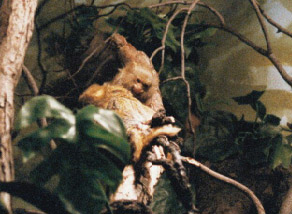The average body mass of an adult pygmy marmoset ranges between 85 and 140 grams with a mean mass of 119 grams, making it the smallest New World primate (Soini, 1988). The total length of adults ranges from 331 to 362 millimeters, with an average of 339 millimeters (Soini, 1988). The dental formula on the upper and lower jaw is 2:1:3:2 (Ankel-Simons, 2000). This small size of the pygmy marmoset is the result of exceptional phyletic dwarfism (Ferrari, 1993); this species evolved from a larger sized callitrichid. This species has thumbs, which are nonopposable, and the nails are claw-like except for the first digit on each toe. The claws (tegulae) are used to cling to large vertical supports (Kinzey et al., 1975). The forelimbs are relatively long, but the radii are relatively short having an advantage in the lateral placement of the forelimbs when vertically clinging when feeding (Thorington and Thorington, 1989). The canines are shaped like incisors, which are equal in shape to the canines, a possible adaptation for excavating exudate holes (Coimbra-Filho and Mittermeier, 1976, 1977).
The adult pygmy marmoset has a dorsal pelage coloration that is mostly tawny agouti (Soini, 1988). Adults have a dark gray or blackish semi-striated pattern from the legs to the mid-dorsum (Soini, 1988); in immature individuals the pelage from the legs to the lower back is gray-ticked (Soini, 1988). Ventrally, adults from the chest downwards have a coloration that ranges from drab or light ochraceous to white (Soini, 1988). On the neck, under the chin, there is sometimes a faint, vertical streak of the same color as the ventral pelage (Soini, 1988). The tail of this species is faintly to conspicuously annulated (Soini, 1988). The tail has a small black terminal hair tuft (Aquino and Encarnacion, 1994). The scrotum of adult males is mottled with heavy black pigmentation, and the external genitalia of females are not pigmented (Soini, 1988). Black pelage borders the anogenital region of adult males and females (Soini, 1988); this is developed in the juvenile (5-12 months) (Soini, 1988). On the face there is a vertical nasal ridge stripe that is buffy to white in color (Soini, 1988). White spots may occur over either mouth corner (Soini, 1988).

